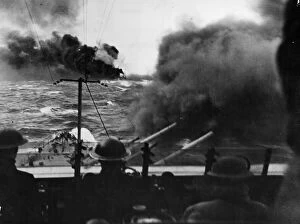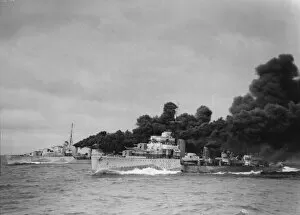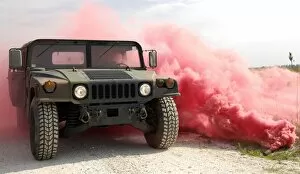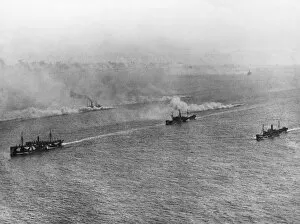Smoke Screen Collection
"Smoke Screen: Concealing the Secrets of War at Sea and on Land" In the midst of the chaos and uncertainty that defined World War II
For sale as Licensed Images
Choose your image, Select your licence and Download the media
"Smoke Screen: Concealing the Secrets of War at Sea and on Land" In the midst of the chaos and uncertainty that defined World War II, smoke screens emerged as a powerful tool in the arsenal of British forces. From the Mediterranean Sea battles to training drills on land, these ephemeral veils played a crucial role in shaping history. As British troops advanced through treacherous barbed wire during a September 1943 training drill, their movements were shrouded by billowing smoke. This ingenious tactic not only protected them from enemy fire but also disoriented their adversaries, giving them an upper hand in battle. On the vast expanse of the Mediterranean Sea, Italian Fleet units found themselves engaged by a formidable British convoy escort. Desperate to gain an advantage, they were met with an impenetrable wall of smoke emanating from HMS Fury and HMS Ashanti. The largest smoke screen ever deployed in warfare concealed their intentions and allowed for strategic maneuvers that ultimately led to victory. Meanwhile, on Italy's Fifth Army Front, infantry units like the Glasgow Highlanders and Coldstream Guards doubled across flat terrain under cover of dense smoke. Their stealthy advance caught enemies off guard as they pressed forward towards triumph. Not limited to just land operations, naval vessels such as HMS Kelvin demonstrated their prowess by laying intricate smokescreens while serving with Home Fleet's 5th Destroyer Flotilla. These ethereal curtains shielded ships from prying eyes and provided vital protection during critical moments at sea. The Royal Air Force collaborated closely with ground forces during this era, showcasing its might through large-scale demonstrations involving fighters and bombers. These aerial spectacles served two purposes - impressing army personnel with air superiority while simultaneously utilizing smoke screens to conceal military strategies from potential threats. One notable instance occurred near Caumont when British tanks rolled forward alongside infantry units amidst a new offensive launched behind an imposing cloud of thick white fog-like substance.

















